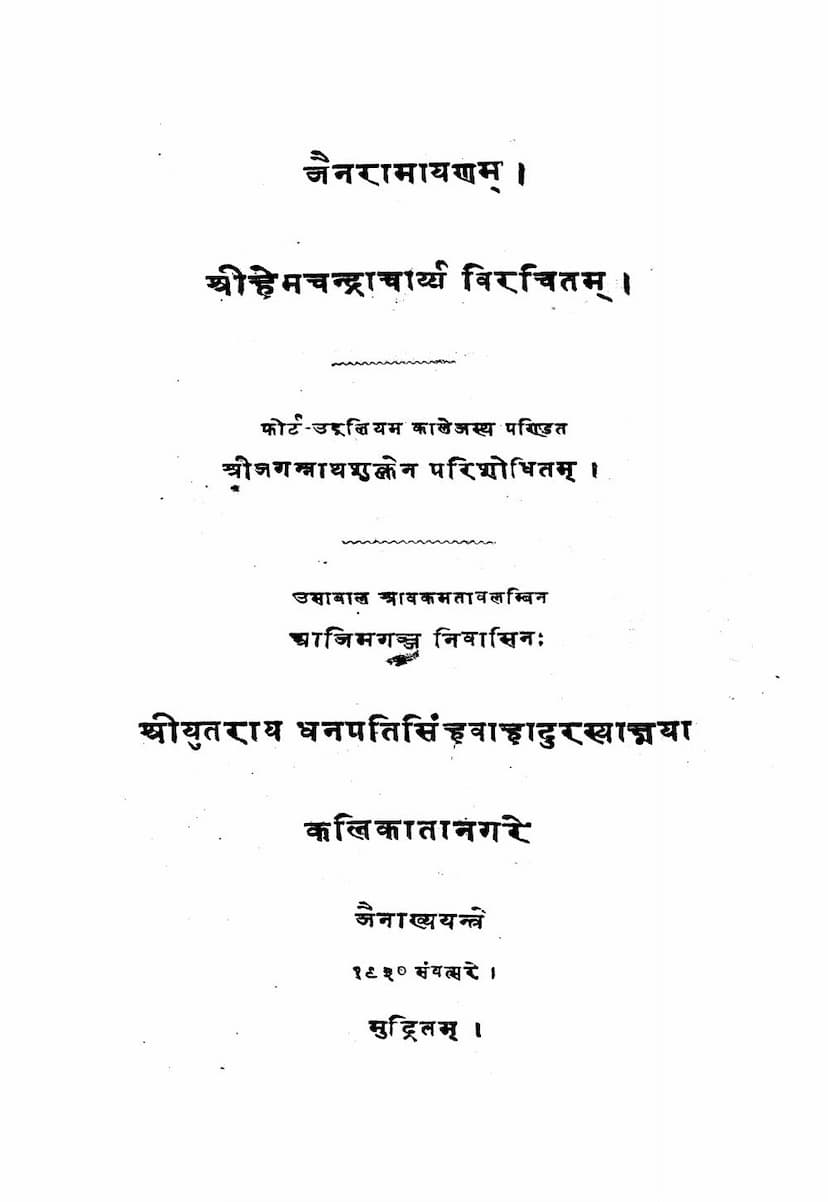Jain Ramayanam
Added to library: September 2, 2025

Summary
Here's a comprehensive summary of the provided Jain text, the "Jain Ramayanam," based on the pages you've shared:
Overall Context and Publisher Information:
The text is titled "Jain Ramayanam" and is attributed to Hemchandracharya. It was revised and published in 1830 AD in Kolkata by the Jain Press under the patronage of Shriyut Rai Dhanpat Singh Bahadur, who is described as a follower of the Oswal sect and a resident of Agam Gachh. The dedication emphasizes its for "private and personal use only."
Genealogy and Patronage (Pages 3-4):
The initial pages (3-4) provide a detailed genealogy of the patrons who sponsored the publication. It traces the lineage back to three brothers from the Modara family, renowned for their piety. The text mentions specific individuals like Budhsingh, Bahadursingh, Pratapsingh, Lakshmipati, and Dhanpati Singh, highlighting their religious devotion and the fact that Dhanpati Singh was instrumental in publishing the "Ramayanam" composed by Hemacharyaji. The publication date is also mentioned in relation to the Vikramaditya era.
Introduction to the Jain Ramayana (Page 5):
The "Ramayanam" itself begins by stating that it will narrate the lives of Shri Suvrata Swami, the Jinendra, and the stories of Baldev, Padm, Vishnu, Narayan, and their adversaries like Ravana. It establishes the setting in Bharata in Jambudvipa, specifically in a city named Vineeta, described as the "jewel of the earth."
Narrative of King Sagara (Pages 5-8):
The text then shifts to the story of King Sagara, who belonged to the Ikshvaku dynasty. He embarks on a journey on a horse. The narrative describes him conquering his opponents and facing a challenge from a Rakshasa who tries to steal his horse. Sagara retrieves the horse and continues his journey. He encounters a beautiful maiden by a lake, whom he mistakes for a celestial being. The text then introduces a story about the maiden's father, Sahasranayana (thousand-eyed), and her abduction by a king named Purnamegha. Sahasranayana seeks the help of Sagara. This segment sets the stage for a complex narrative involving kings, celestial beings, and potential conflicts.
Previous Births and Origins of Conflict (Pages 9-12):
The story delves into previous births to explain the conflicts. It explains the enmity between Purnamegha and Haridas, stemming from a past life where Haridas's father was a wealthy merchant who was killed by Purnamegha's father. This act led to a cycle of revenge. The text then introduces Sukeśa, a Vidyadhar king, whose daughter Sulochana was desired by many, including Kirtidhavala. The narrative continues to explain the complex web of relationships and past actions that fuel the present conflicts. The text also introduces Meghavahana, son of Purnamegha, who seeks refuge in a samavasarana (assembly of the enlightened).
Key Themes and Characters Introduced:
- Jain Ethical Framework: The emphasis on past deeds (karma), dharma, piety, and seeking refuge in divine beings (Jinas) points to the Jain worldview.
- Reincarnation and Karma: The recurring theme of previous births explaining present conflicts is central.
- Royal and Celestial Beings: The narrative features kings, Vidyadharas (celestial beings with magical powers), and their interactions.
- Conflict and Resolution: The story highlights animosity, abduction, and the pursuit of justice, with the intervention of religious figures or divine principles being implied for resolution.
- Genealogy and Dynasties: The Ikshvaku dynasty and the lineage of Vidyadhara kings are mentioned, establishing the historical and social context within the Jain cosmology.
Overall Impression:
The "Jain Ramayanam" appears to be a Jain adaptation of the epic Ramayana, reinterpreting the characters and events through a Jain lens. It likely emphasizes the principles of karma, non-violence, and the pursuit of spiritual liberation, while weaving a narrative rich in previous lives, celestial interactions, and the consequences of actions across lifetimes. The detailed genealogical information points to the significant role of lay patrons in the preservation and dissemination of Jain scriptures.